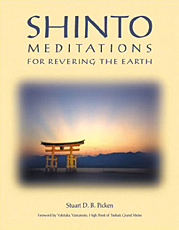Stuart D. B. Picken, an ordained minister in the Church of Scotland, has taught religion in Japan since 1972 and is International Advisor to the High Priest of the Tsubaki Grand Shrine. In this handy resource, he has assembled eight litanies built around Shinto norito (invocations of the divine). Each one contains seven levels: observation, invocation, inspiration, purification, meditation, relation, and celebration. They are organized around the four seasons and can be used indoors or outdoors in what Picken calls "the Cathedral of Great Nature."
The author notes early in the book: "Japanese reverence for nature grew out of a sense of living in a divine environment, one that made the development of human society both desirable and possible. Nature was perceived as self-renewing, a cyclical movement of life that should be marked and celebrated at every important juncture." Pickens points out two Shinto rituals that illustrate this tradition's emphasis upon purifying an environment. Japanese wash the entrance way in the morning to prevent misfortune from coming in. They leave little piles of salt outside restaurants or businesses before they open in order to cleanse the environment. Pickens outlines the misogi ritual where water is the purifying and renewing agent.
One of the litanies deals with stones. In Shinto, a stone that radiates great power, dignity, and elegance must be adorned with a sacred rope and revered. Pickens points out that rocks used in Japanese gardens often make those who view them catch their breath. In this litany, we ask the stone to teach us the meaning of purity, brightness and uprightness of the soul. We meditate on their strength, beauty, and ability to provide shade or shelter. And we respect stones for pointing to the divine.
Other litanies celebrate earth. waterfalls, rivers, trees, wind and lightning, fire, and mountains. Shinto Meditations is tailor-made for those seeking a deeper connection with the natural world and rituals designed to evoke reverence.
